Opportunities for improvement exists on many dairies in second and subsequent insemination (2nd+) efficiency for lactating cows and age at first calving (AFC) for heifers.
Recently completed research by Dr. Julio Giordano, a Cornell University Animal Science Professor, evaluated ways to manage these two components.
Managing second and subsequent A.I. of lactating cows
Sound strategies for second and subsequent breedings (2nd+) are critical to achieve optimum reproductive efficiency, and ideally should include timed artificial insemination (TAI) options. Roughly 20 to 40 percent of breeding-eligible cows will not be found in estrus by 50 to 60 days after previous A.I., thus extending the interbreeding interval. There are a few challenges to breeding cows after their initial service.
First, about 20 to 30 percent fail to successfully respond to an estrus synchronization protocol. Second, most TAI protocols take several days to execute, which adds significantly to the interbreeding interval. Finally, initiating some TAI protocols too early after a previous A.I. may decrease estrus expression, which is not ideal for herds intending to breed cows seen in heat.
New research trials conducted by Dr. Giordano’s laboratory examined strategies for 2nd+ breedings in herds with good estrus detection and enrolled cows weekly in rebreeding protocols.
The first trial compared cows from two New York State commercial dairy farms enrolled in two different rebreeding programs. At the time of non-pregnancy diagnosis (NPD) open cows received either a Resynch-32 protocol (32 days after A.I. GnRH, PGF2α seven days later, GnRH 56 hours later, and TAI 16 to 18 hours later, Figure 1) or a Short-Resynch (SR) program.
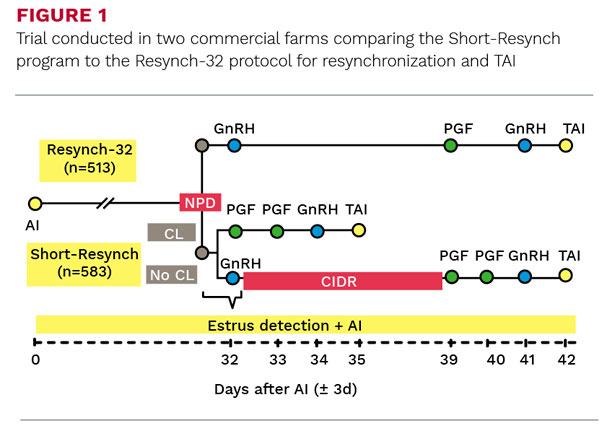
Cows assigned to the SR program received one of two treatments based on the presence or absence of a corpus luteum (CL) and a follicle. Cows with at least one CL >15 mm and follicle >10 mm received PGF2α twice 24 hours apart, followed by GnRH 32 hours after the second PGF2α, and TAI 16 to 18 hours later. Cows in SR that did not meet these ovarian criteria (No CL and/or no follicle) received CIDR-Synch with two PGF2α treatments (Figure 1).
The SR cows with CL were expected to have a shortened interbreeding interval (35 ± 3 days) without the need to treat them before pregnancy diagnosis, which could reduce estrus expression for those cows that show heat after their previous AI.
The results of this trial showed that the SR group had a significant reduction in days to pregnancy (fewer days open) and more cows were pregnant by 210 days after first AI when compared with the Resynch32 group (Table 1).
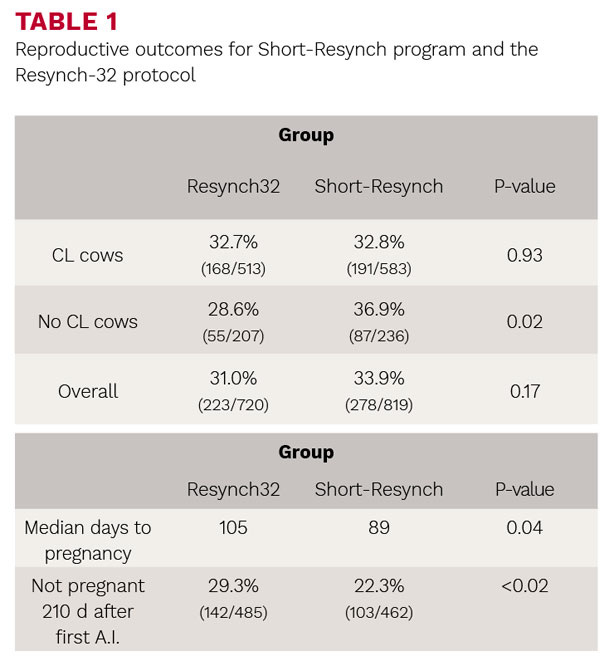
For cows without a CL at NPD, conception rate (CR) was greater in the SR group, which likely contributed to overall improved performance. The SR group had a higher likelihood of pregnancy during lactation and a shorter median time to pregnancy than the Resynch32 group.
Two other trials evaluated the Short-Resynch program and its effect on repro performance. In both trials, the same resynchronization treatments were compared except that the main outcomes evaluated were different. In both trials, one group of cows received the same Short-Resynch (SR) program used in the previous experiment.
The second group received a treatment similar to SR except that cows received GnRH one week prior to NPD, around 25 days after first insemination (Resynch-25) (Figure 2).
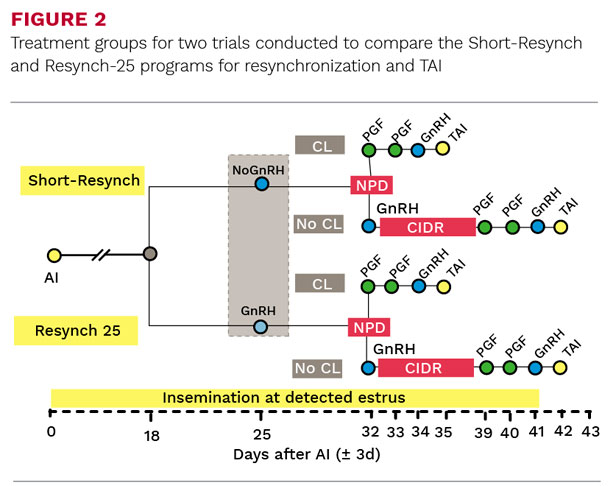
In all cases, cows with NoCL and/or no large follicle at NPD received CIDR-Synch. The main interest of the researchers was to determine the consequences of skipping the initial GnRH in SR. Giving GnRH 25 days after breeding, like in a Resynch-25 protocol, would be expected to decrease heat expression before NPD by about 10 to 20 percent.
Thus, by not giving this GnRH treatment, herds with successful heat detection programs can capitalize on reducing the interbreeding interval by inseminating more cows in heat before NPD. Also, labor and breeding costs can be lowered by decreasing the number of GnRH injections given. The downside to not giving this initial GnRH is a decrease in P/A.I. for cows with a CL bred to the timed A.I. protocol.
Results from the first trial conducted at the Dairy Unit of the Cornell University Ruminant Center (CURC) confirmed that a higher proportion of cows in the SR group were bred in heat prior to NPD and that CR was lower but still acceptable for cows with a CL at NPD (Table 2).
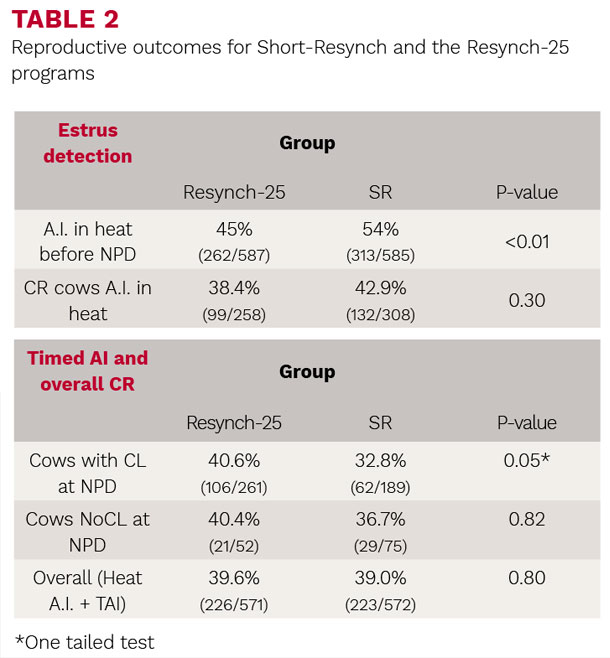 Interestingly, the final proportion of cows pregnant (combining heat and TAI breedings) was the same because of compensation between more heat breedings in SR or improved CR for TAI breedings in Resynch-25 (Table 2).
Interestingly, the final proportion of cows pregnant (combining heat and TAI breedings) was the same because of compensation between more heat breedings in SR or improved CR for TAI breedings in Resynch-25 (Table 2).
In the last trial conducted in two commercial dairy farms, the main objective was to evaluate time to pregnancy and the proportion of cows pregnant at the end of the breeding period. In agreement with the previous experiment at CURC, reproductive performance was similar for both groups, suggesting that both can be successfully used by dairy farms (Table 3).
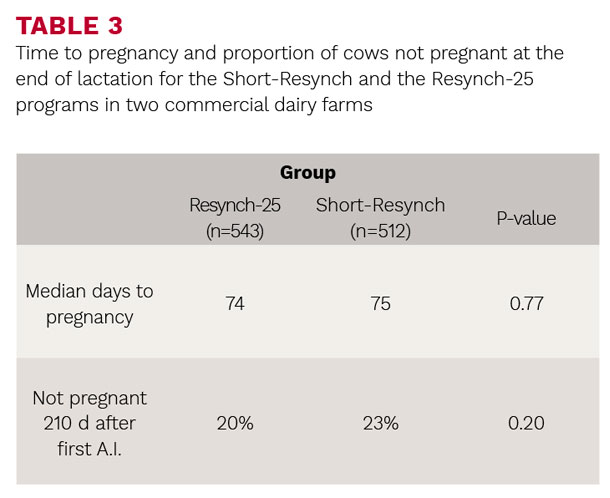
Based on these series of trials it was concluded that the most critical factor for program selection is the expected or known heat detection efficiency after previous breedings. Farms with excellent heat detection and CR to heat breedings may benefit by the SR program.
These farms can breed more cows in heat and reduce reliance on TAI. Conversely, farms with poor heat detection or low CR to heat breedings may greatly benefit by using the Resynch-25 program.
Results from these trials show that herds with good heat detection and weekly re-breeding programs can improve their reproductive efficiency by choosing protocols based on ovarian status. These shortened Resynch protocols can result in a high proportion of cows bred in heat while shortening the interbreeding interval, and improving CR in cows most likely to benefit from progesterone supplementation.
Heifer first-service reproductive management
Replacement animal raising costs represent roughly 15 to 20 percent of the dairy’s operational expenses. In reality, much of the time required to raise replacement animals is relatively fixed (pre-weaning, post-weaning, gestation). Dairies can make marginal improvements in age at weaning and age at sexual maturity.
The biggest area of opportunity on most dairies is to reduce average time and variation for age at first calving (AFC) through earlier pregnancy after the end of a heifer voluntary waiting period (VWP). Farms should consider implementing a breeding management plan that will ensure all heifers get inseminated as close to the end of the VWP as possible.
In collaboration with Dairy Herd Management Services (DHMS; Lowville, NY), Dr. Giordano’s laboratory analyzed reproductive performance and farm profitability relative to three heifer-breeding programs.
Heifers on three New York dairies were assigned randomly to one of three first-service breeding protocols of increasing breeding intensity. The first group (PGF+EDAI) received up to three PGF2α treatments every 14 days for breeding after induction of estrus starting at the end of the VWP, around 12 months of age.
Any heifer not bred by nine days after the third PGF started on a five-day Cosynch with CIDR TAI protocol (5dCP [GnRH + CIDR-5 d-CIDR removal and PGF2α-3 d-GnRH and TAI]; Figure 3).
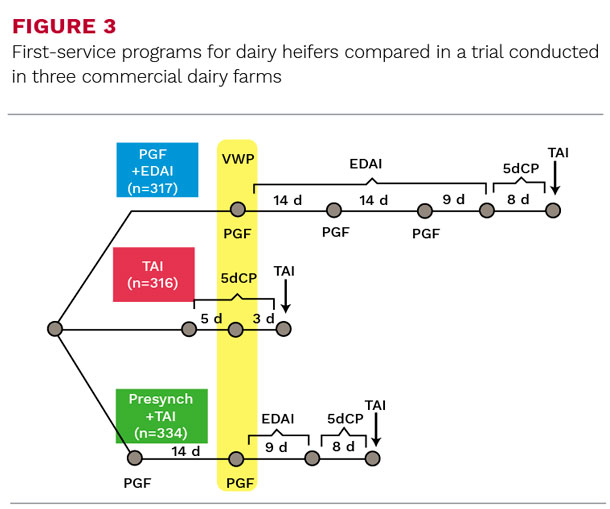
The second group (Presynch+TAI) were given PGF2α 14 days prior to the VWP and again at the VWP. Heifers seen in estrus during the nine-day period after the second PGF2α were bred. Those heifers not bred were started on 5dCP. The third group of heifers (100 percent TAI) were bred using the 5dCP protocol started five days prior to the VWP.
All heifers were observed for estrus for around 33 days after first AI and enrolled in another 5dCP protocol if not re-bred in heat. Heifers were followed for 15 months after the end of the VWP capturing reproductive outcomes, rearing costs and first-lactation profit. From a cash flow perspective, the best heifer breeding strategy depended on how well the participating farms detected estrus.
For the farms with good estrus detection (A & B), the Presynch+TAI protocol provided the best cash flow per heifer slot over the 15-month observation period. For the farm (Farm C) with low estrus detection (a deliberate management decision), preliminary results showed the 100 percent TAI protocol provided the best cash flow per heifer slot. If the data holds for this farm, the economic advantage for the 100 percent TAI group will be substantial.
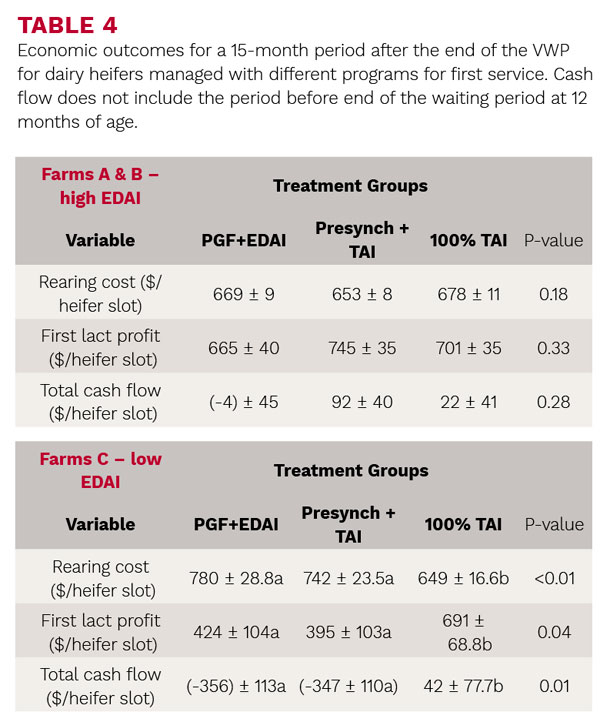
By accounting for breeding program expenses, rearing cost savings and additional first lactation profit, this research provides the dairy industry with a better understanding of the financial impacts of improving AFC with good heifer reproductive management.
Dr. Giordano’s research was partially funded by grants from the New York Farm Viability Institute (NYFVI) and National Institute of Food and Agriculture, U.S. Department of Agriculture, Hatch under 1007421 and Multistate 100572.
Any opinions, findings, conclusions, or recommendations expressed in this publication are those of the authors and do not necessarily reflect the view of the National Institute of Food and Agriculture (NIFA) or the United States Department of Agriculture (USDA).
Rob Lynch, DVM, is a Dairy Herd Health and Management Specialist with Cornell CALS PRO-DAIRY. Email Rob Lynch. Julio Giordano is a Professor of Dairy Cattle Biology and Management at the Department of Animal Science at Cornell University. Email Julio Giordano.
This article appeared in PRO-DAIRY’s The Manager in July 2018. To learn more about Cornell CALS PRO-DAIRY program, visit PRO-DAIRY Cornell CALS.








